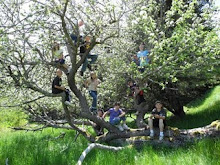
I thought of titling this: A Shameless Plug for the Naturemill Composter. As part of our Community Garden grant through Healthy Acadia and MDI YMCA, we purchased an indoor composter. I did a lot of research before hand. This HAD to be too good to be true. An indoor composter that took kitchen scraps, including meat and dairy, only used $0.50 worth of electricity a month, and spit out fresh compost every two weeks. Nah. Couldn't be. But then I read reviews and consumer responses. Barring a little occasional jamming, apparently this wasn't a hoax. So, I put in for one when I wrote the garden grant. Since school was ending when we received the Naturemill, I brought it home with us to read the guide and try it out. In went the first batch of soil (to add the beneficial microbes) from my garden, compostable materials like tea leaves, greens and bread, saw dust, and baking soda (an alkalyzer that cuts down on smell and acidity).
 The thing turns on its own, rotating with a low whirring noise every few hours. We keep it under the cabinet and barely notice the noise.
The thing turns on its own, rotating with a low whirring noise every few hours. We keep it under the cabinet and barely notice the noise. And, two weeks later. No kidding. This is truly what came out. It's amazing stuff, really. No bad smells, great color and texture, no recognizable 'chunks'. I think I will have to take a photo of my long term composter bins out back for a comparison. They are currently filled with straw and three years after installation, I can't say that there's a lot of this rich looking earth coming out!
And, two weeks later. No kidding. This is truly what came out. It's amazing stuff, really. No bad smells, great color and texture, no recognizable 'chunks'. I think I will have to take a photo of my long term composter bins out back for a comparison. They are currently filled with straw and three years after installation, I can't say that there's a lot of this rich looking earth coming out!


No comments:
Post a Comment